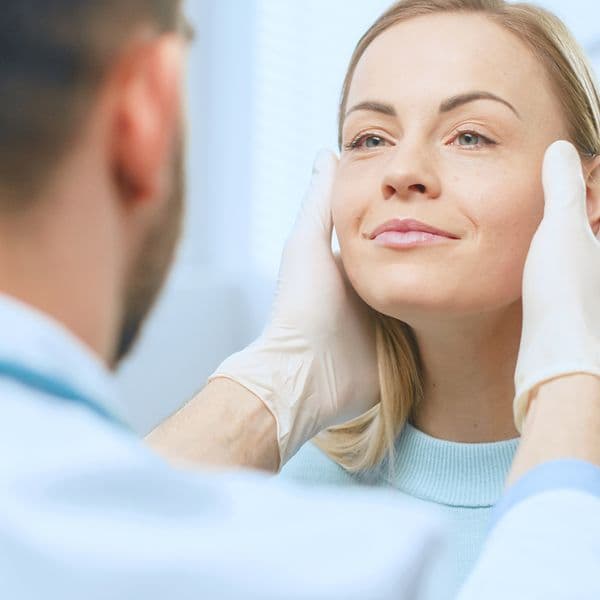Deep Plane Facelift
- Dr. Harmon is one of the few surgeons in the world – and the only surgeon in Cincinnati – who is fellowship-trained in the extended deep plane facelift by its creator
- Improves healing and reduces the risk of a pulled look when compared with older facelifting techniques because it is focused on lifting volume rather than pulling skin
Contact Us
What is Deep Plane Facelift?
The deep plane facelift is a surgical procedure in which incisions are made around the ears and hairline to release and lift volume in the face that can fall with age. A small area of skin around the ears is lifted. Then, cheek fat and jowls are lifted along with muscle and connective tissue in the center of the face. This deep plane approach is extended into the lateral neck where skin and muscle are lifted to enhance the effects of a neck lift. A deep plane facelift procedure that extends the deep plane approach into the neck is called the extended deep plane facelift. Tight attachments in the cheek and lateral neck are released to minimize tension. This released facial and lateral neck volume are lifted together, superiorly and laterally, and secured under the skin. Excess skin is removed. The incisions are then closed under little-to-no tension. This procedure can improve healing and reduce the risk of a pulled, distorted look when compared with older techniques. The technique does, however, require extensive training to perform successfully and consistently. Dr. Harmon is one of the few surgeons in the world – and the only surgeon in Cincinnati – who is fellowship-trained in the extended deep plane facelift by its creator.
What Conditions Does the Procedure Address?
The purpose of deep plane facelift surgery is to lift volume in the cheeks and jawline that have fallen to create a more youthful, heart-shaped appearance to the face. The conditions deep plane facelift surgery, especially the extended deep plane facelift, can help address include:
Before & After
Explore our galleries to see the stunning, natural results Dr. Harmon delivers.
Why Choose Dr. Harmon
The desire for youthfulness is understandable. There is no area more important than the face. After all, the face cannot be hidden. It is how we present ourselves to the world. Dr. Harmon works with a refined eye and trained hands to develop a personalized treatment plan with you, utilizing advanced techniques in surgical and non-surgical care of the face, nose, eyes, neck and hair.
Fellowship trained facial plastic surgeons have a unique specialized skill set in performing surgical and non-surgical procedures on the face, nose, eyes, neck and hair. The pathway to becoming a facial plastic surgeon begins with five years of rigorous training in head and neck surgery. This training is focused on all aspects of surgery for the head and neck, in addition to aesthetic and reconstructive procedures.
A small pool of top performing graduates from head and neck surgery programs are then selected to complete sub-specialty training as a fellow in facial plastic and reconstructive surgery through the American Academy of Facial Plastic and Reconstructive Surgery (AAFPRS).
Dr. Harmon completed his fellowship in facial plastic surgery through the AAFPRS with the world-renowned facial plastic surgeon Dr. Andrew Jacono on Park Avenue in New York City. Dr. Jacono is world renowned for developing the extended deep plane facelift technique. Dr. Harmon is one of the few surgeons in the world, and the only surgeon in the Cincinnati area, fellowship trained in this technique by Dr. Jacono.
Quad A Accredited Surgery Suite
Harmon Facial Plastic Surgery is proud to have a Quad A accredited operating room and facility in our office. Our single-physician, single-specialty facility meets or exceeds the strict guidelines and high standards set forth by Quad A, demonstrating our strong commitment to patient safety and excellence in surgical care. We utilize the services of board-certified anesthesiology physicians only as well as our own personal clinical support staff to ensure the most comfortable, safest experience for our clients.
Overview of the Procedure
The team at Harmon Facial Plastic Surgery works tirelessly to prepare patients well for their procedure. The time spent with patients and resources provided facilitates a smooth transition from the procedure through recovery. The following overview is a broad summary of the information provided to patients:
Procedure Consultation
Expect a detailed, informative discussion with Dr. Harmon about your concerns and aesthetic goals. He will develop a personalized treatment plan to address these concerns and goals.
Pre-Treatment Preparation
Patients receive a packet with detailed pre-operative instructions prior to surgery. This packet includes information on what supplements and medications to hold prior to surgery, activity restrictions, and what supplies are necessary for post-operative recovery. Prescriptions are sent prior to surgery with instructions on their use. Finally, if medical clearance is required, a form detailing the necessary clearance and testing is provided to present to their primary care provider.
Day of Treatment
Patients are instructed to arrive at the office in comfortable clothes. The surgical plan is discussed with the patient in detail. Paperwork is completed. Photos are usually taken pre-operatively. Finally, the patient meets the surgical team, which may include nurses, anesthesiologists, and/or scrub technologists, depending on the procedure(s) and type of anesthesia used. A loose-fitted dressing is applied and small drains are placed in the neck during surgery.
Follow-Up Appointment
Patients follow up one (1) day after surgery to remove the dressing. The drains may also be removed one (1) day after surgery, depending on the drain output. Patients may follow up on day two (2) after surgery as well. Subsequent follow up appointments are approximately five (5), seven (7), and ten (10) days after surgery to remove sutures.
Social Readiness
The exact time in which patients feel ready to socialize depends on multiple factors, including their comfort with the visibility of incisions, bruises, and swelling. Makeup can be applied to the neck approximately ten (10) days after surgery. Most patients feel ready to socialize approximately fourteen (14) days after surgery, though they are still healing and will continue to do so for months after surgery.
Ideal Candidates for a Deep Plane Facelift
Ideal candidates for deep plane facelift surgery include those patients who demonstrate age-related changes to their face such as:
- Jowls
- Fallen cheeks
- A loss of definition of the jawline, with the soft tissue of the face blending in with the neck
Most candidates for deep plane facelift surgery range in age from their forties (40s) to their seventies (70s). A consultation is essential to determine candidacy for the procedure, because there may be factors that preclude this procedure for certain individuals. Reasonable expectations must be established about what deep plane facelift surgery can and cannot accomplish. As with all facial plastic surgery procedures, results can vary.
What to Expect from Recovery
Recovery from deep plane facelift surgery is specific to the patient. The initial recovery time from deep plane facelift surgery is approximately ten (10) to fourteen (14) days for most individuals. However, the duration of recovery will vary from person to person.
Dressings are removed the day after surgery. Drains, which are placed because a deep plane facelift is performed with a neck lift, are usually removed one (1) day after surgery if the drain output is appropriately low. Sutures are removed in a staged, progressive manner over approximately ten (10) days. Swelling and bruises are expected after deep plane facelift surgery. Post-operative swelling and bruises generally improve significantly by ten (10) to fourteen (14) days after surgery.
The healing process does not end after fourteen (14) days, however. For example, the incision continues to heal for months after surgery. Swelling and bruises are expected to continue to improve and resolve in the ensuing days and weeks.
Drains are removed
Sutures are removed
Swelling and bruises are improved
Initial recovery
Benefits of a Deep Plane Facelift
A deep plane facelift helps address many features of age-related changes to the face. The potential benefits of a deep plane facelift include:
- Lifted cheeks, which can reduce the appearance of heaviness over the upper lip and create a more youthful interface between the cheeks and the lower eyelids
- Lifted jowls, which can make the jawline appearance longer and more youthful
- Improved definition of the jawline
- An overall transition from a bottom-heavy appearance to a more heart-shaped appearance to the face
Risks of a Deep Plane Facelift
The potential risks of a neck lift include, but are not limited to:
- Bruising
- Swelling
- Infection
- Bleeding
- Skin color changes
- Nerve damage
- Abnormal scarring
Combine a Deep Plane Facelift with Other Facial Enhancements
Deep plane facelift surgery complements other surgical and non-surgical procedures well. Procedures that complement deep plane facelift surgery include, but are not limited to:
Neck lift
A neck lift can refine the jawline and eliminate loose skin beneath the chin. It may complement the lift and contour achieved through a deep plane facelift. Together, they can help create seamless rejuvenation from the face through the neck.
Brow lift
A brow lift can enhance the expressive upper third of the face by gently lifting the brow and smoothing forehead lines. Paired with a deep plane facelift, it may support a more refreshed, balanced, and naturally elevated look.
Lip lift
A lip lift shortens the space between the nose and upper lip, enhancing lip definition and youthful proportion. When combined with a deep plane facelift, it can subtly complete the rejuvenation around the mouth.
Blepharoplasty
Rejuvenating the eyelids through blepharoplasty enhances brightness and clarity in the eyes, one of the most expressive facial features. This, paired with a deep plane facelift, may create a more comprehensive renewal with refined detail.
Rhinoplasty
Refining the nose with rhinoplasty may elevate the overall facial balance achieved with a deep plane facelift. This combination helps create aesthetic harmony in both profile and frontal views for a well-balanced and elegant look.
Fillers
Strategic use of fillers after a deep plane facelift can help fine-tune areas like the lips, chin, or under-eye hollows. This pairing allows for custom contouring that supports a soft finish that may elevate the overall effect.
Botox©
Botox© help smooth dynamic wrinkles and soften expressions, subtly enhancing the structural rejuvenation of a deep plane facelift. Together, they may promote a naturally relaxed, refreshed, and polished appearance.

Book Your Consultation
Take the first step toward your aesthetic goals with a personalized consultation. Dr. Harmon will listen to your concerns, answer your questions, and guide you through your options. Schedule your consultation today and discover how expert care can make a difference.
Read More About Deep Plane Facelift

4 Benefits of the Extended Deep Plane Facelift
Dr. Jeffrey Harmon Learn More About Our Deep Plane Facelift Schedule a Consultation The most natural, longest-lasting approach to a facelift is the...

Overview of Facelift Techniques
The following information is adopted from a lecture I give to head and neck surgery residents at the University of Cincinnati on the aging face and...

Four Strategies to Reduce Swelling after Deep Plane Facelift Surgery
Swelling is normal and expected after any facelift surgery, including the extended deep plane facelift. It gradually resolves without intervention in...
FAQ
What type of anesthesia is required?
The extended deep plane facelift can usually be performed under IV sedation. Some individuals may require general anesthesia.
Will I look "pulled" or unnatural after a facelift?
The extended deep plane facelift can prevent the appearance of being "pulled" through the release of multiple tension points in the face and neck through the deep plane approach. This can result in a natural and tension-free lifting of drooping tissue.
Do men benefit from the extended deep plane facelift?
Absolutely. Men experience similar age-related changes to their face as women. As a result, they experience similar benefits from the extended deep plane facelift as women.
Will the extended deep plane facelift get rid of my wrinkles?
The extended deep plane facelift, unique among facelift techniques, can significantly improve the deep folds between the cheek and the lip, also known as the melolabial folds. However, fine facial wrinkles that are a result of changes to the top layers of the skin and not loose, drooping soft tissue and fat is better treated with laser resurfacing (CO2 laser). Fortunately, laser resurfacing (CO2 laser) can be performed at the same time as an extended deep plane facelift, which enhances the results of the facelift.
Will the extended deep plane facelift treat my deep tear troughs?
The tear trough is a ligament extending from the facial bones to the skin. A youthful face demonstrates a smooth curve and transition from the lower eyelid to the cheeks. The tear troughs can become more visible with the drooping of cheeks and the development of lower eyelid bags, both of which breaks that smooth transition. The extended deep plane facelift can improve the appearance of the interface between the lower eyelid and cheeks. However, lower eyelid bags are the primary contributor to deepened tear troughs. Therefore, one should not expect the extended deep plane facelift to treat their deep tear troughs. Lower eyelid surgery (blepharoplasty) is generally the best treatment for deep tear troughs.
Will the presence of dermal filler in my face prevent me from having a facelift?
Not necessarily. The extended deep plane facelift can generally be performed with dermal filler in the face.
What is the best age to get a facelift?
The best age for a facelift is entirely dependent on the individual, their aesthetic goals, as well as their anatomy and medical history. It also depends on how early a patient would like to enjoy the results! The age range in which most patients undergo a facelift is late 40s to late 60s.
How long does the extended deep plane facelift last?
The extended deep plane facelift, like every other facial plastic surgery procedure, does not stop the aging process. The primary goal of the extended deep plane facelift is to make an individual look like themselves, only younger. That being said, the extended deep plane facelift can last much longer than other facelift approaches, which often need to be "revised" within a few years. The extended deep plane facelift can last 12 – 15 years, which is quite a long time compared with other approaches.
Will I have drains after the extended deep plane facelift?
Yes. One drain is placed on either side of the neck. Each comes out through a small opening in the hair, which usually heals beautifully after they are removed. The drains are usually removed the morning after surgery unless the drain output necessitates leaving them in for additional time.
Will my earlobes be altered after extended deep plane facelift surgery?
One risk of facelift surgery is the stretching and alteration of the lower earlobes, called a pixie ear deformity. This is usually due to excess tension on the skin and an incision carried to far onto the earlobe itself. This risk can be minimized by performing deep plane surgery which eliminates tension on the incision and allowing 1 - 2 mm of skin beyond the earlobe to preserve the earlobe sulcus.
Can hyperbaric oxygen (HBO) therapy improve healing after extended deep plane facelift surgery?
Hyperbaric oxygen (HBO) therapy has been used for many years to treat chronic wounds. The procedure has been shown to improve the delivery of oxygen to tissue and reduce tissue injury. Most assume HBO therapy is used only for patients who are experiencing poor blood flow to the skin after a facelift. In fact, there is some evidence that treatment with HBO can accelerate the resolution of bruising after facelift surgery. This could potentially benefit patients who would like to return to work or their social lives more quickly. The option for HBO treatment is discussed with patients prior to extended deep plane facelift surgery. People who could potentially benefit from HBO therapy include patients with a recent history of smoking or those who have undergone a facelift or non-surgical face tightening procedure elsewhere, because the blood supply to the tissue of the face, including the skin, is weakened. Patients who pursue HBO therapy undergo a consultation with the physician who administers the therapy where he extensively reviews their medical history and performs a physical exam to determine their candidacy for treatment.
Is the extended deep plane facelift a painful procedure?
Facial plastic surgery procedures are generally well-tolerated by patients and typically involve little pain, especially when compared with surgery on other areas of the body. Patients are usually prescribed just a small amount of pain medication for after surgery. In fact, we have found most use only over-the-counter pain medication including acetaminophen and/or ibuprofen after surgery instead. And those who do use the prescribed pain medication usually only use it the first night after surgery. With that in mind, it is important to note that every patient perceives and processes pain differently. Some patients have a high pain tolerance. Others may be more predisposed to be more sensitive to pain. We at Harmon Facial Plastic Surgery are focused on balancing minimizing post-operative discomfort and maximizing safety.
Can a facelift be performed without a neck lift?
The face and neck are considered together because the anatomical structures blend together. Therefore, a facelift is almost never performed without a neck lift. The approach to the neck lift does depend on each individual's specific anatomy.
Will the extended deep plane facelift distort my hairline?
No, the extended deep plane facelift utilizes a minimal-access approach that preserves the hairline. This can be done because there is no tension on the skin with an extended deep plane facelift, allowing the incision to be hidden at the hairline without distorting it.
Will I have long, visible incisions?
Dr. Harmon utilizes a minimal-access approach to the extended deep plane facelift that hides incisions around the ear and along the hairline. The fact that the extended deep plane facelift results in no tension on the skin allows these incisions to heal significantly better than other facelift approaches which place undue tension on the skin.
Will the extended deep plane facelift get rid of my smoker's lines (peri-oral rhytids)?
No. While the extended deep plane facelift can significantly improve the severity of melolabial folds, peri-oral rhytids require a dual-pronged approach independent of a facelift. Dr. Harmon utilizes the patient's own fat, refining it into a fine injectable called nano-fat, to fill the deepest lines around the mouth. He then utilizes an advanced laser, called a fractional CO2 laser, to resurface the skin. The action of the laser as well as the fat cells (adipocytes) from the nano-fat enhance the healing of the skin, allowing more organized, youthful collage to form around the mouth, thereby reducing the appearance of smoker's lines.
Will my nasolabial folds and marionette lines improve after extended deep plane facelift surgery?
The nasolabial folds and marionette lines develop as a result of superficial fat pads drooping and exposing ligaments surrounding those fat pads. They are important areas of the face that delineate different subunits. As a result, they are essential. However, they often become more pronounced with age. The extended deep plane facelift can often, though not always, improve both the nasolabial folds and marionette lines because the release of tension points in the cheeks and jawline allow a lift of the deep tissue away from these ligaments.
How many years younger can a facelift make me look?
Many sources explain that the goal of a facelift procedure is to make individuals look approximately ten (10) years younger. However, this is, at best, conjecture. The goal of facelift surgery should be to bring sagging volume closer to where it was before, thereby improving some of the natural volume contours to a more youthful-appearing position. A 'goal age' should not be the aim of facelift surgery; rather, an overall natural, more youthful appearance should be the goal. We at Harmon Facial Plastic Surgery feel strongly that the extended deep plane facelift is the best procedure to accomplish this.
Will I heal at the same rate on each side of my face (symmetrically) after the extended deep plane facelift?
The healing process differs for each side of the face. That is partially due to the fact that every face is asymmetric. It is not unexpected for one side of the face to heal faster than the opposite side, including more bruising and swelling on one side compared with the other.
Will my ear be removed and replaced during extended deep plane facelift surgery?
No, the ear is not removed and replaced during an extended deep plane facelift or any other facelift technique/approach. This is an understandable, common misconception. The incisions for the extended deep plane facelift are simply hidden in the complex curves and crevices of the ears without actual removal of the ear cartilage or earlobe.
Where should I expect to swell the most after extended deep plane facelift surgery?
Some swelling is expected after facelift surgery, regardless of the approach/technique used. As previously stated, the swelling generally improves significantly in 10 to 14 days such that most individuals can return to their normal daily routine with some exercise restrictions. Swelling is expected to continue to improve and resolve over a period of weeks. One possible explanation for this is that the lymphatic drainage system is temporarily affected by facelift surgery. The lymphatic drainage system, located all over the body, removes body fluid from tissue and returns it to the blood. The lymphatic drainage system helps improve and resolve swelling. One small study from Aesthetic Surgery Journal in 2012 evaluated the lymphatic drainage system in 3 patients who underwent a facelift (4). Lymphoscintigraphy was performed prior to surgery and at multiple time points after surgery on these patients. Lymphoscintigraphy involves the use of a material that is injected into tissue and which is absorbed by the lymphatic drainage system and can be detected on imaging. The study demonstrated that the locations for the lymphatic fluid to drain was restricted to areas under the jaw immediately after facelift surgery. The patients realized an improvement in lymphatic drainage by 3 months after surgery and a normalization of the drainage patterns by 6 months. This is a possible explanation as to why swelling in the area under the jaw, called the submental space, can take slightly longer to resolve than in other areas with any facelift approach/technique.
Is a facelift a common surgical procedure?
Yes, a facelift is a common surgical procedure. The International Society of Aesthetic Plastic Surgery (ISAPS) releases statistics each year that provide insight into the state of plastic surgery around the world. ISAPS reported 56,084 facelifts were performed in the United States in 2020.
Written by Dr. Harmon
Discover the expertise and compassionate care of Dr. Jeff Harmon, a fellowship-trained facial plastic surgeon deeply rooted in the Cincinnati community. A former collegiate athlete and Cornell University graduate, Dr. Harmon brings discipline, precision, and a global perspective to his surgical practice—refined through elite fellowship training in New York City.
Located in Hyde Park, Harmon Facial Plastic Surgery proudly serves patients throughout the Cincinnati area offering personalized facial aesthetics with world-class skill and a hometown heart.